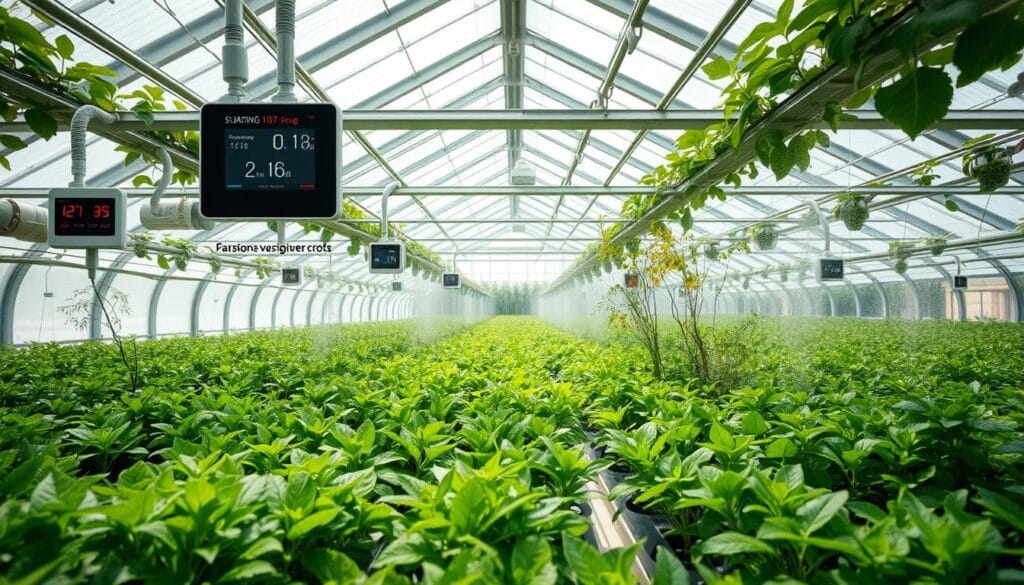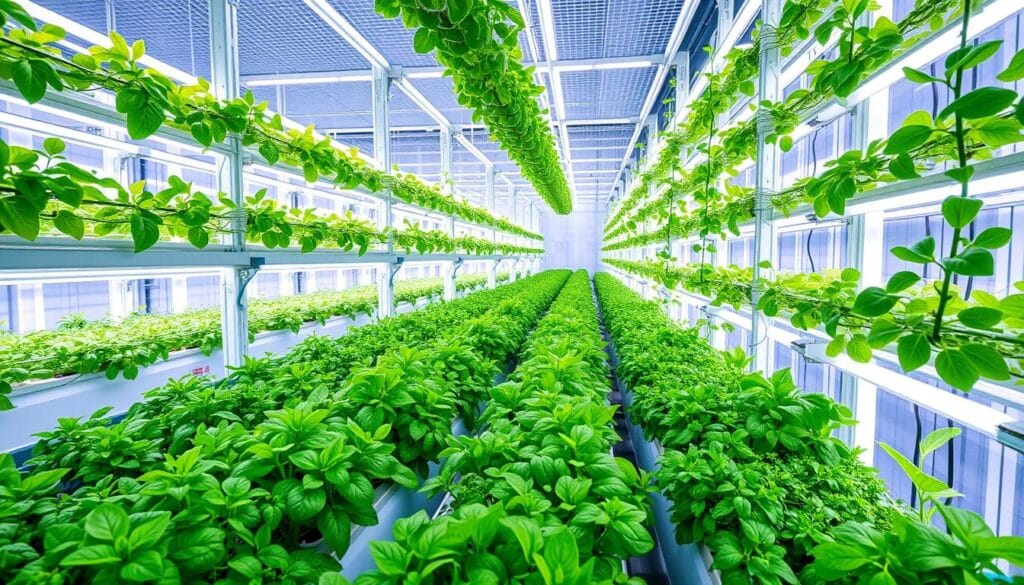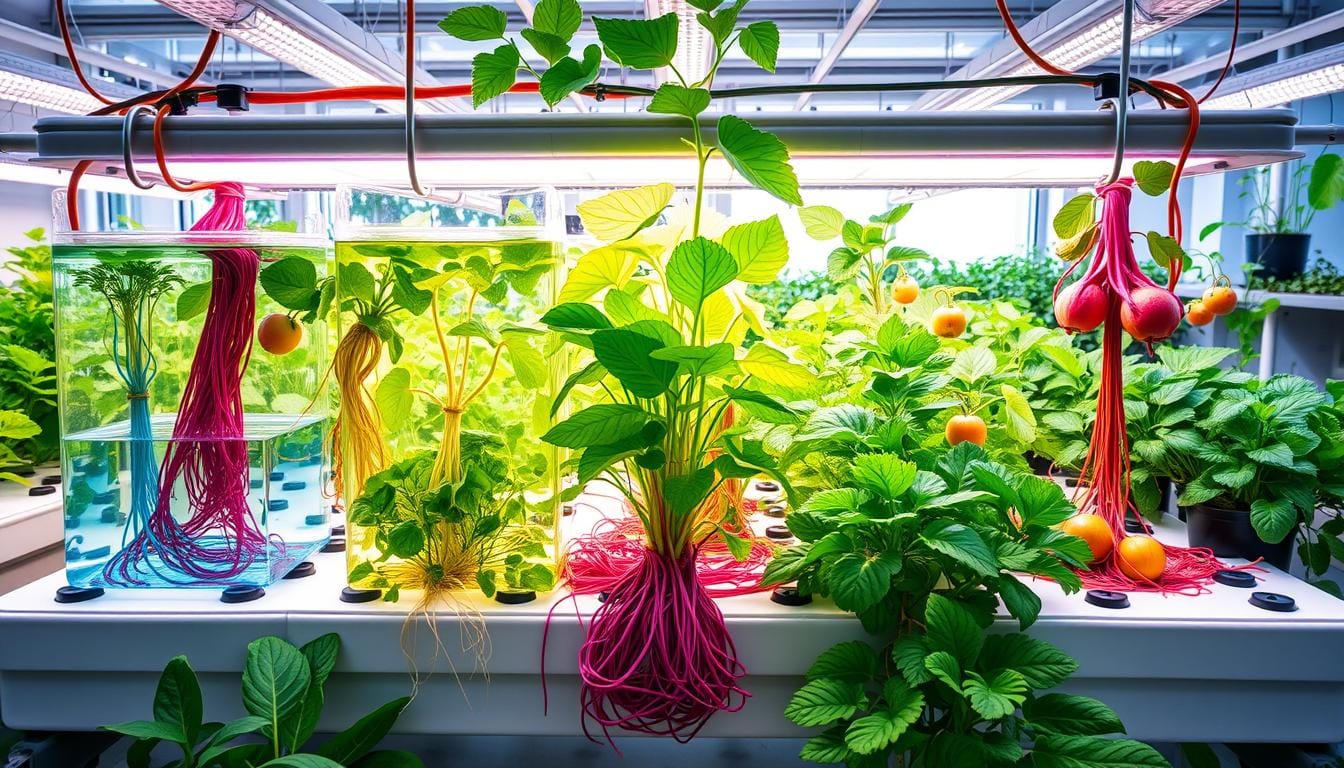I’ve always been drawn to hydroponics, the art of growing plants without soil. It’s amazing how nutrients can be given directly to the roots, leading to faster growth and healthier plants. If you’re interested in this approach, you’re in for a pleasant surprise.
Hydroponics is more than a trend. It’s a sustainable way to grow many crops, from herbs to vegetables. Learning about the growth cycles in hydroponics will help you create an amazing garden. Your garden will not only be productive but also show off your green thumb.
Key Takeaways
- Hydroponics can increase crop yields by up to 50% while using 80% less water than traditional agriculture.
- Plants grown in hydroponic systems can mature up to 50% faster than those cultivated in soil.
- Hydroponic systems offer a controlled environment for optimal nutrient delivery and plant growth.
- Mastering the essential growth cycles is key to achieving thriving hydroponic gardens.
- Proper nutrient management, environmental control, and maintenance are crucial for successful hydroponic cultivation.
Understanding Hydroponic Growing Systems
Hydroponic systems change the way we garden, making soil unnecessary. They use nutrient-rich solutions to feed plants. This method supports a wide range of plants, from greens to fruits and herbs.
Types of Hydroponic Systems
Hydroponics has many systems, each for different plants. You’ll find Nutrient Film Technique (NFT), Deep Water Culture (DWC), and Ebb and Flow systems. These systems control water and nutrients for the best plant growth.
Basic Components and Setup Requirements
A hydroponic system has a water reservoir, nutrient solution, and growing medium like Rockwool. You might also need air pumps, grow trays and circulation systems. Setting up and keeping these parts right is key to success.
Advantages of Soilless Cultivation
Hydroponic gardening has many benefits. It can boost crop yields by 50% and use 80% less water. Plants grow 50% faster than in soil. It also means no herbicides or pesticides, leading to healthier crops.
Hydroponic systems are exciting for both new and experienced gardeners. Knowing the types, components, and benefits helps choose the right system. This way, you can achieve your gardening goals.
Growth cycles in hydroponics
Mastering the growth cycles in hydroponics is key to growing healthy plants and big harvests. Each stage, from seedling to flowering, needs the right nutrients, light, and environment. Hydroponics lets growers control these factors closely, helping plants grow better at every stage.
The journey starts with germination, where seeds sprout and grow their first roots. Next, the seedling growth phase helps young plants develop their first true leaves. Then, the vegetative phase lets plants grow their leaves and roots fast, getting ready for the flowering stage.
In the vegetative phase, plants need 40 inches of light, 50% light lamps for 18 hours a day. The temperature should be 73/64 degrees Fahrenheit, and the water 70 degrees. In the second week, all lamps should be on, 20 inches from plants, at 75/64 degrees Fahrenheit.
The flowering stage uses a 600-watt HPS light at full intensity, 20 inches away, for 12 hours a day. The temperature should be 77/65 degrees Fahrenheit. It’s important to adjust the TDS and pH levels throughout to help plants absorb nutrients well and stay healthy.
Understanding and managing hydroponic growth cycles well can help growers get the most from their plants. This leads to faster growth, bigger yields, and more consistent harvests.
Essential Nutrient Management for Plant Development
Effective nutrient management is essential for successful hydroponic gardening. It’s important to balance macronutrients and micronutrients for optimal plant growth.
Macronutrients vs. Micronutrients
Macronutrients like nitrogen, phosphorus, and potassium are needed in large amounts. They help with leaf growth, root development, and flowering. Micronutrients, such as calcium and magnesium, support plant functions in smaller amounts.
pH Levels and Nutrient Absorption
Maintaining a pH level between 5.5 and 6.5 is vital for optimal nutrient absorption. This range helps plants take in nutrients from the nutrient solution efficiently, promoting healthy growth.
Solution Maintenance and Monitoring
It’s important to regularly check and adjust the nutrient solution. This helps maintain the proper electrical conductivity (EC) and pH balance. Daily checks and adjustments are needed, with a full solution change every two weeks. Automated systems can make this easier, keeping nutrient levels and pH consistent.
In organic hydroponics, natural sources like seaweed extracts and compost teas are used. They offer a well-balanced blend of nutrients essential for plant growth.
“Effective nutrient management is crucial in hydroponic systems, as it guarantees that plants obtain the necessary elements for optimal growth and development.”
Understanding macronutrients, micronutrients, pH levels, and solution maintenance is vital. Hydroponic gardeners can create a rich environment for their plants to thrive.
Environmental Control in Hydroponic Gardens
Keeping the right environment is key to your hydroponic garden’s success. Controlling temperature, managing humidity, and ensuring proper air circulation are essential. A grow tent provides a controlled space, improving light use and protecting plants from outside.
Good ventilation is crucial for air flow and temperature. It stops air from getting stuck and prevents too much moisture. Using air conditioners and dehumidifiers helps keep the right temperature and humidity. This is especially important in cold months to help plants absorb nutrients well.
“Hydroponic gardening is believed to consume approximately 95% less water compared to conventional open-field farming methods.”
By managing your garden’s environment well, you can grow a lot of food sustainably. The right conditions in your grow tent are essential for success.
Hydroponic tech is changing farming for the better. It lets people grow food even where it’s hard to farm. This way, more people can grow their food, no matter the land they have.
Light Requirements Throughout Growth Stages
Proper lighting is key for healthy hydroponic plant growth. LED grow lights have become the preferred option for indoor gardeners.. They offer energy-saving and full-spectrum light, like natural sunlight. The light needs of your plants change a lot based on their growth stage and type.
Natural vs Artificial Lighting
Natural sunlight is the best light, but it’s not always available or enough for indoor hydroponics. LED grow lights provide a light spectrum that meets your plants’ needs at every stage. These lights are cool, so you can place them close to your plants without harming them.
Light Cycles for Different Plants
Leafy greens do well with 10-14 hours of light a day. Tomatoes and peppers need 14-18 hours. It’s important to keep the right light scheduling to help plants grow and bloom.
Optimizing Light Intensity
The light’s intensity, or Photosynthetic Photon Flux Density (PPFD), impacts plant growth. Different plants need different light levels. Leafy greens require 150-250 μmol/m²/s, whereas fruiting plants need 600-800 μmol/m²/s. Growers use light meters to check and tweak the light intensity for the best growth.
Temperature and Humidity Management
Keeping the right climate is key for your hydroponic plants to grow well. Most plants do best in temperatures between 68°F and 75°F (20°C to 24°C). Humidity should be between 50% and 70% for them to thrive.
To control temperature, use fans, air conditioning, and good ventilation. Digital thermometers and infrared sensors help keep the temperature steady. This supports strong roots and better nutrient uptake.
Humidity is also crucial for your garden. Use humidifiers, dehumidifiers, and adjust air flow to keep humidity right. Proper watering, like the “wet-dry” cycle, also helps manage humidity.
By managing the climate control, you give your plants the optimal growing conditions for healthy growth. Good heat management strategies are key to getting the most from your hydroponic garden.
| Growth Stage | Ideal Temperature Range | Ideal Humidity Range |
|---|---|---|
| Seed Germination | 20°C to 25°C | 72% to 100% |
| Vegetative Growth | 18°C to 24°C | 58% to 65% |
| Flowering/Bloom | 20°C to 27°C | 48% to 55% |
By keeping the right temperature and humidity levels, you create the best environment for your hydroponic plants to flourish.

Water Quality and Circulation Systems
In hydroponic gardening, keeping the water quality high is key for healthy plants. It’s important to have the right amount of dissolved oxygen, control the temperature, and use good filtration. These factors help your plants grow well in soilless cultivation.
Dissolved Oxygen Levels
Dissolved oxygen (DO) levels between 5 to 8 milligrams per liter (mg/L) are crucial. They help roots grow strong and plants absorb nutrients well. This DO range is vital for a healthy root system and plant growth.
Water Temperature Control
The temperature of the nutrient solution is very important. It should be between 65°F and 80°F (18°C to 27°C) for best growth. This range helps plants absorb nutrients well and keeps harmful microbes away.
Filtration Methods
Using methods like reverse osmosis (RO) can greatly improve water quality. RO systems remove almost all impurities, giving plants a clean, nutrient-rich solution. This is especially important in areas with hard water, which can cause nutrient imbalances.
Good water circulation is also key. It makes sure nutrients and oxygen are spread evenly. Regular cleaning of water reservoirs stops algae and keeps the system working well.
| Parameter | Ideal Range | Importance |
|---|---|---|
| Dissolved Oxygen (DO) | 5-8 mg/L | Promotes healthy root growth and nutrient uptake |
| Water Temperature | 65-80°F (18-27°C) | Ensures optimal nutrient absorption and prevents microbial growth |
| pH | 5.5-6.5 | Facilitates optimal nutrient availability and absorption |
| Filtration | Reverse Osmosis (RO) | Removes impurities and ensures water purity for nutrient delivery |
By keeping the water quality high and using good circulation systems, you can create the best environment for your hydroponic plants. This will help them grow and be productive.
Plant Support and Training Techniques
In the world of vertical farming and hydroponic cultivation, plant support and training are key. They help make the most of small spaces and increase yields. These methods let growers use their space wisely.
Vertical farming lets plants grow in a stacked way. Growers use trellising, pruning, and topping for vine crops like tomatoes and cucumbers. This ensures plants get enough light and air, leading to better health and more produce.
- Trellising: This method uses structures like cages or stakes to support plants. It makes the most of vertical space.
- Pruning: Removing certain leaves, branches, or flowers helps plants grow better. It boosts space efficiency.
- Topping: Cutting off the plant’s top tip encourages side branches. This makes the plant more compact and easier to manage.
These techniques not only save space but also improve light and air for plants. This results in healthier plants and more produce.
“Effective plant support and training methods are crucial for optimizing the potential of your hydroponic system. With a little creativity and attention to detail, you can transform your vertical farming setup into a thriving, productive oasis.”
By using these plant training methods, you can reach the full potential of your vertical farming. This leads to a bountiful and space-efficient harvest.

Disease Prevention and System Maintenance
Keeping your hydroponic garden healthy means fighting pests, cleaning regularly, and stopping algae. Use an integrated pest management (IPM) plan to control pests safely. Check your system often for diseases or pests and fix problems fast.
It’s also key to keep your hydroponic system clean. Algae can ruin water quality and slow down plant growth. Clean and disinfect all parts of your system, like tubing and grow media, with a bleach or hydrogen peroxide solution.
Keeping the nutrient solution’s pH and EC levels right is vital for plant health. Watch these levels closely and adjust them when needed. Also, manage water temperature, dissolved oxygen, and other factors to keep your garden strong and disease-free.
Focus on pest control, system cleaning, and algae prevention to have a thriving garden. Taking care of your system leads to healthy plants and a good harvest.
“A properly maintained hydroponic system forms the foundation for a flourishing and productive garden.”
Conclusion
Hydroponic gardening is a green and efficient way to grow crops. IIt’s perfect for urban areas and places with scarce land resources. By controlling nutrients, light, temperature, and water, hydroponics can grow more food with less water and space.
The future of farming and growing plants indoors is bright. Thanks to new tech, hydroponics will help meet the world’s food needs. Schools, hospitals, and other places are using hydroponics to give everyone access to fresh, healthy food all year.
By teaching hydroponics in schools, we’re preparing the next generation. They’ll learn how to grow food in a way that’s good for the planet. Hydroponics can grow 50% more food with 80% less water, making it a key solution for our food challenges.

